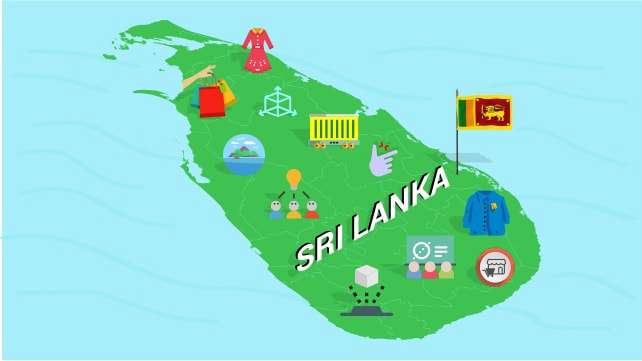
The fashion consumership in Europe and North America is undergoing decisive changes within the current retail apocalypse, putting the pressure on brands to reinvent their game; but meanwhile, the fashion consumer markets in Southeast Asia are growing exponentially, particularly for luxury spends like international designer brands. Among these, we’re turning the spotlight to a new and relatively untapped consumer market holding remarkable potential for the international fashion brands — this is Sri Lanka.
Jude Gayantha Perera, Chief Curator behind Colombo’s favourite professional styling service Stylist.lk says, “ Sri Lanka’s market for international luxury fashion brands is on the cusp of a renaissance. ”
With the insights of fashion business professionals like Perera, and local fashion consumers, we’re mapping out the Top Ten Reasons Why Sri Lanka is the Next South Asian Market that International Brands Should Enter.
1. A Market Left Almost Untouched For Thirty Years
It’s still under a decade since Sri Lanka’s civil war ended. During the thirty years of conflict, Sri Lanka’s international reputation as a market waned and many international operations left its shaky commercial sphere. Therefore, the island market was left untouched until it started gaining stability recently amidst the country’s post-war developments. Today, the market is seen not only as stable but also as a place that displays a distinct growth rate with an evident interest in lifestyle and luxury purchases such as fashion.
2. High Conventional and Digital Literacy Leading to Accessibility to Global Trends
Sri Lanka’s free education system has managed a phenomenally high literacy rate over the years. What does this have to do with fashion purchasing? Interestingly, a significant much. Sri Lankans’ ability to read and interact via digital channels has led them to have a much higher tendency to read and watch international fashion content, from magazines, online shows and digital screenings to trend updates. This has led to a consumership with relatively high awareness of the value and appeal that international fashion brands hold.
3. Size vs. Density
Sri Lanka is minuscule in size, but judging the capacity of its market with this single piece of information is definitely a mistake. Sri Lanka is a dense island with a population of over twenty-one million (and growing). With several key commercial hubs like Colombo, Kandy, Jaffna and Galle distributed around the island, the number of consumers spread throughout the country is significant and growing.
4. The Hunger for International Retail Experiences
Let’s face it, the passports of developing nations — especially those like Sri Lanka with past conflicts that led to international dispute — make travelling the world an exhausting, and often impossible, experience. This has created a definite hunger for experiencing exotic lifestyle elements seen on film, television, magazine covers or mostly, online. For many fashion consumers in Sri Lanka, an opportunity to experience their favourite international fashion brands on offline channels, at retail fronts as real, immersive experiences are highly desirable. It’s one major reason why global brands that enter the country call in major appeal and interest from the get-go.
“I mean, yes, we can go through the hassle of going to Bangkok once a year to shop Hugo Boss or Dior but being able to do that in Colombo will be amazing. Because the whole experience of international brands and their incredible retail stores is unique and you can’t get that online…” – Hasitha Alagiyawanna, CIM Student and Luxury Fashion Shopper tells Apparel Resources .
5. Boom in Upper-middle Class
A common reason for many Southeast Asian nations to become recognised as the top consumer markets for fashion is this undeniable explosion of the upper-middle classes, owing to increasing incomes and accessibility to products and services. Sri Lanka too has been experiencing this shift leading to a greater interest in designer products, lifestyle purchases, luxury spends and unusual retail experiences.
“There are enough people with the means but not the options. I call this Sri Lanka’s pocket dimension, which is not 1% — I would say up to 10% of the total market.” – Jude Gayantha Perera, Stylist.lk
6. The Island Culture
What does Sri Lanka being an island have to do with how the markets respond to international brands? Sociological observations on island nations often study their receptiveness of hostility towards strangers and foreign phenomena. Although this becomes irrelevant in this globalised, hyper-connected world, the cultural practices and ideologies deep-rooted into societies from centuries ago are still in place.
In Sri Lanka’s case, being strategically well-placed almost at the very centre of international sea and air routes has made the island extremely receptive to new ideas and foreign elements. Even today, Sri Lankan markets are surprisingly receptive to foreign products, brands and retail fronts, making it a welcoming place to make business.
7. Complicated Import and Postal Laws Outweighing Conveniences of E-commerce
While e-commerce is definitely on the rise, Sri Lanka’s import regulations, and lack of last-mile-delivery setups mean that most consumers still prefer cash on delivery or straight up retail—especially for fashion where fit and look are of paramount importance. This opens up more room for traditional retail even within at the thick of the digital revolution, especially for those carrying the appeal of international brands.
8. A Thriving Creative Culture
Sri Lanka has a growing community of creative practitioners giving rise to a leading group of consumers who fuel a new visual culture. This means that with the growing number of designers, photographers, stylists, curators, artists etc. whose intrinsic interest and unusual viewpoints on style and fashion, Sri Lanka is seeing the beginning of strong trends, visual subcultures and Instagram-worthy portrayals of creative lifestyles. This is a strong influencer for consumer directions and buying patterns, often inspiring new interest in lifestyle purchases.
“Sri Lanka’s culture is vastly image conscious. Motivations are beyond affluence. Sometimes, the way you dress in Colombo is a real decision maker on your work promotion.” – Jude Gayantha Perera, Stylist.lk
9. Major Influx of Travellers Opening Up Destination Shopping
Sri Lanka has been topping travel lists since 2012 with high-spending travellers on the rise. The number of inbound travellers is always on the rise, and a niche that every brand is trying to get in on is travel retail. Of course, fashion retail for travellers is not the same as those targeting domestic markets. But, Sri Lanka’s constant flux of globetrotters is an excellent opportunity for luxury brands to target their destination collections, travel wardrobes and seasonless looks that work with the island’s forever-summer tropical appeal.
10. Fashion Literacy
This is probably one of the most important reasons why fashion brands should have Sri Lanka on their mind. The island has been investing in international standard fashion education for well over a decade now, primarily to supplement its massive apparel industry with creative insight. An unexpected result of this has been a general increase in fashion literacy, leading to a knowledgeable fashion consumership, well-tuned-in to the makes and moves of international style. That is an already converted audience.

Leave a Reply